Click on images to enlarge
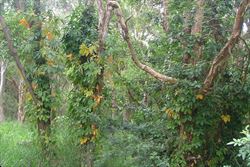
infestation (Photo: Sheldon Navie)

climbing habit (Photo: Sheldon Navie)

habit climbing on a fence (Photo: Sheldon Navie)

creeping habit with juvenile leaves (Photo: Sheldon Navie)
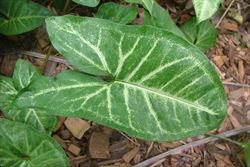
the arrowhead-shaped juvenile leaves are sometimes variegated (Photo: Sheldon Navie)

three-lobed intermediate leaf at the base of the climbing stems (Photo: Sheldon Navie)

thick climbing stem with leaf sheath and aerial roots beginning to develop (Photo: Sheldon Navie)
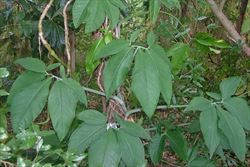
much larger adult leaves with several leaflets (Photo: Sheldon Navie)

adult leaf with much larger central leaflet (Photo: Sheldon Navie)
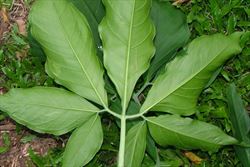
underside of leaflets (Photo: Sheldon Navie)
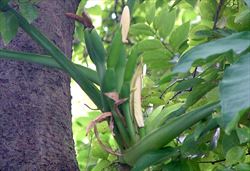
the flower clusters are borne in groups of 4-11 in the forks of the fleshy upper leaf stalks (Photo: Sheldon Navie)
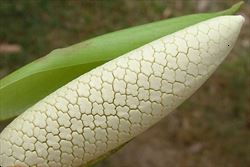
close-up of cream-coloured, cross-shaped, male flowers partially enclosed in a green bract (Photo: Sheldon Navie)
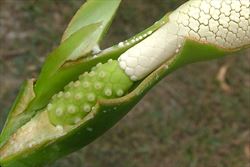
close-up of green female flowers at the base of the flower cluster (Photo: Sheldon Navie)

immature fruit with withered brown bracts (Photo: Sheldon Navie)
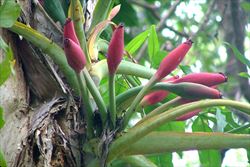
mature fruit eventually turn bright red in colour (Photo: Sheldon Navie)
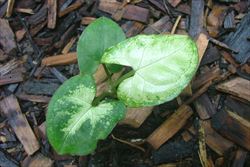
'seedling' with heart-shaped leaves (Photo: Sheldon Navie)

the juvenile leaves of Syngonium podophyllum 'White Butterfly' (Photo: Sheldon Navie)
Scientific Name
Syngonium podophyllum Schott
Family
Araceae
Common Names
African evergreen, American evergreen, arrowhear plant, arrowhead vine, fivefingers, goosefoot, goosefoot plant, goose's foot, nephthytis
Origin
Native to Mexico, Central America (i.e. Belize, Costa Rica, El Salvador, Guatemala, Honduras, Nicaragua and Panama), parts of the Caribbean (i.e. Trinidad and Tobago) and tropical South America (i.e. French Guiana, Guyana, Surinam, Venezuela, Brazil, Bolivia, Colombia, Ecuador and Peru).
Cultivation
Syngonium (Syngonium podophyllum) has been widely cultivated as a garden ornamental and indoor plant, particularly in the warmer parts of Australia. Numerous cultivars are available, with the most popular probably being Syngonium podophyllum 'White Butterfly'.
Naturalised Distribution
This species is naturalised in the coastal districts of south-eastern, central and northern Queensland. It currently has a scattered distribution, but is quickly becoming more common and widespread. Possibly also becoming naturalised in south-western Western Australia.
Also naturalised on some Pacific islands (i.e. American Samoa, Niue and Hawaii) and in south-eastern USA (i.e. Florida).
Habitat
Syngonium (Syngonium podophyllum) prefers moist shady conditions and fertile soils. It is a weed of rainforests, closed forests, open woodlands, waterways and riparian areas, roadsides, disturbed sites, waste areas and abandoned gardens in tropical and sub-tropical regions.
Habit
A rampant creeper or climbing plant that grows over other vegetation, often reaching 5-10 m or more in height when climbing larger trees.
Distinguishing Features
- a creeping or climbing plant with leaves that vary in size, shape and colour depending on their position on the plant.
-
the lower leaves are generally arrowhead-shaped and either entirely green or with some silvery-white markings.
-
the upper leaves are generally light or dark green and divided into three segments or 5-9 separate leaflets.
-
the 'flowers' consist of an elongated whitish spike that is surrounded by a creamy-white to greenish structure.
-
the fleshy fruit are red to reddish-orange in colour and usually hidden.
Stems and Leaves
The younger stems are sometimes slightly bluish-green in colour (i.e. glaucous) and often contain a milky sap (i.e. latex). They are hairless (i.e. glabrous), smooth in texture, and slightly fleshy (i.e. succulent). These stems readily develop roots (i.e. adventitious roots) at their joints (i.e. nodes). Older stems turn pale brown and can become slightly woody (15-25 mm thick), and the climbing stems develop aerial roots which adhere to the tree or structure that they are climbing on.
The alternately arranged leaves vary in size, shape and colour depending on their position on the plant (and also the cultivar). They are borne on stalks (i.e. petioles) 15-60 cm long that are grooved for part of their length and sheath the stem near their base (especially when the leaves are young). The lower leaves (i.e. juvenile leaves) are generally heart-shaped (i.e. cordate) or more commonly arrowhead-shaped (i.e. hastate or sagittate) and have pointed tips (i.e. acute apices). These leaves (7-14 cm long) are dark green in colour or with silvery-white veins or centres bounded by green. The intermediate leaves tend to be slightly larger with more developed and more spreading lobes near the base of the leaf blade. The upper leaves (i.e. mature or aerial leaves) are generally dark green and without any markings. These leaves (12-38 cm long and 6-17 cm wide) are divided into three segments, or may eventually become even more divided and develop 5-11 separate leaflets, with the central one usually being broader and longer than the others. All leaves are hairless (i.e. glabrous), have entire margins or lobes, and have paler undersides.
Flowers and Fruit
Several (i.e. 4-11) flower spikes (i.e. spadices) develop in some of the upper leaf forks and they are borne on stalks (i.e. peduncles) up to 13 cm long. Each of these flower spikes (i.e. spadices) consists of an elongated column (5-9 cm long and 7-15 mm across) that is partially enclosed in a creamy-white to greenish coloured modified leaf (i.e. spathe) that takes on the appearance of a flower. The modified leaf (i.e. spathe) is 9-11 cm long and forms a short greenish coloured tube at its base (3-4 cm long and 1.8-2 cm across). The elongated column has numerous tiny male and female (i.e. unisexual) flowers along it. The 6-9 female (i.e. pistillate) flowers are located at the base of the column and are contained within the tube created by the base of the modified leaf (i.e. spathe tube). These female flowers do not have any petals or sepals and consist of an ovary and a stigma. They are green or greenish-cream in colour, irregularly six-sided, and are densely arranged along the lower 1-2 cm of the column. The numerous male (i.e. staminate) flowers are located above the female flowers and are exposed when the flower spikes are fully open. They are cream in colour (3.5-4 mm wide) and consist of four anthers that are partially or almost totally fused into a cross-shaped structure (i.e. synandrium). It will flower and fruit throughout the year.
The developing fruit remain contained within the greenish tube created by the modified leaf (i.e. spathe tube). The male flowers and the upper part of the modified leaf (i.e. spathe blade) usually turn brown in colour and eventually fall off. The developing fruit turn red to reddish-orange in colour and eventually merge into one larger fruit (i.e. a syncarp). This fruit (3.5-7 cm long and 1.5-3.5 cm wide) is egg-shaped (i.e. ovoid) and turns brownish when fully mature. It contains numerous black or brown seeds (7-11 mm long and 5-7 mm wide) that are contained within a soft greyish-coloured pulp.
Reproduction and Dispersal
This species almost exclusively reproduces vegetatively in the wild, and is propagated and spread by cuttings in cultivation.
Stem segments and cuttings are commonly dispersed in dumped garden waste and woodchips. Once established, a plant will spread outwards, forming a colony, and taking root wherever its stems touch the ground. Stem segments can also be spread by mowers, slashes and floodwaters.
Environmental Impact
Syngonium (Syngonium podophyllum) is regarded as an environmental weed in Queensland, and as a potential environmental weed or "sleeper weed" in other parts of northern and eastern Australia.
Legislation
Not declared or considered noxious by any state government authorities.
Similar Species
Goose's foot (Syngonium podophyllum) is very similar to Syngonium angustatum and Syngonium neglectum. These species are very difficult to distinguish when in the vegetative stage of growth, however they can be separated by the following differences when in flower:
- Syngonium podophyllum has bluish-green (i.e. glaucous) or green younger stems and leaf stalks and its adult leaves have leaflets that are usually somewhat unequal in size, with the central leaflet usually being significantly larger than the others. Its flower clusters are borne in groups of 4-11 in the upper leaf forks and are relatively small (9-11 cm long). The column (i.e. spadix) of each flower cluster (4-9 cm long and 5-15 mm wide) has numerous cross-shaped, cream coloured, male flowers. The narrow tube that encloses the female flowers (i.e. spathe base) is initially green inside and out, but turns bright red as the fruit matures.
- Syngonium angustatum has greenish coloured younger stems and its adult leaves have leaflets that are usually usually somewhat elongated in shape. Its flower clusters are borne in groups of 4-7 in the upper leaf forks and are relatively small (7-14 cm long). The column (i.e. spadix) of each flower cluster (5-9 cm long and 7-15 mm wide) has numerous cross-shaped, cream or pale yellow, male flowers with indented tips (i.e. retuse apices). The narrow tube that encloses the female flowers (i.e. spathe base) is initially green inside and out, but sometimes turns bright red as the fruit matures.
- Syngonium neglectum has greenish coloured younger stems and its adult leaves have leaflets that are usually somewhat unequal in size, with the central leaflet usually being significantly larger than the others. Its flower clusters are borne singly or in small groups of 2-3 in the upper leaf forks and are relatively large (13.5-23 cm long). The column (i.e. spadix) of each flower cluster (9.5-20 cm long and 15-30 mm wide) has numerous irregularly six-sided, whitish, male flowers. The broad tube that encloses the female flowers (i.e. spathe base) is green on the outside but dull reddish-purple on the inside.
Note: These species are very difficult to tell apart by their leaves, and flowering material is usually required to determine which species is present. However, Syngonium angustatum can be separated from the other two species by its smaller and narrower juvenile leaves (i.e. its juvenile laevs are often less than 6 cm long, compared to 7-14 cm long in Syngonium podophyllum and Syngonium neglectum ).

